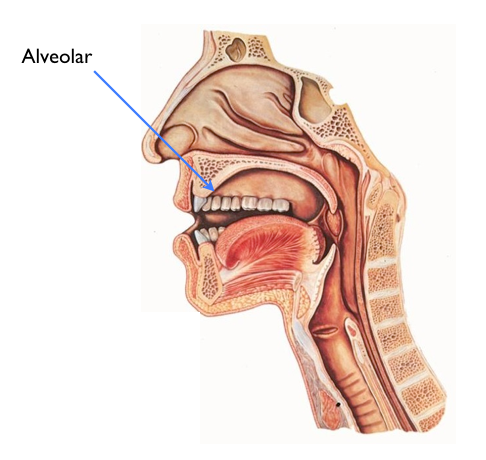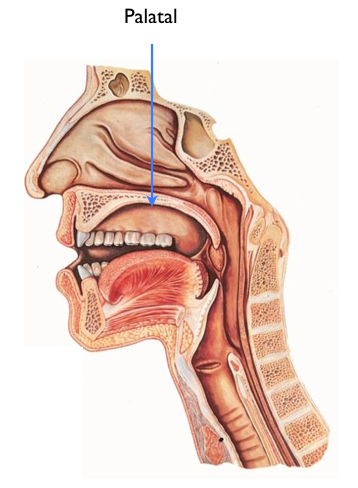Point of articulation
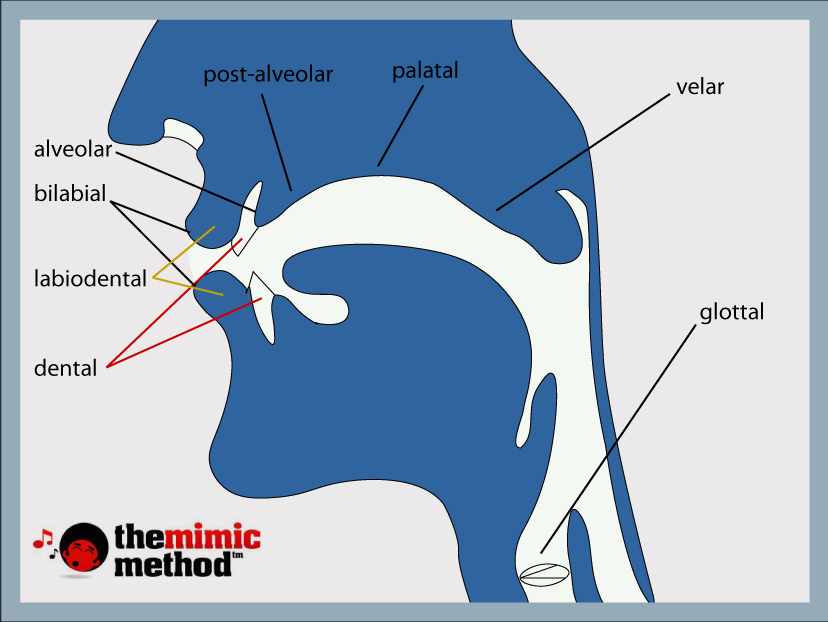
Bilabial
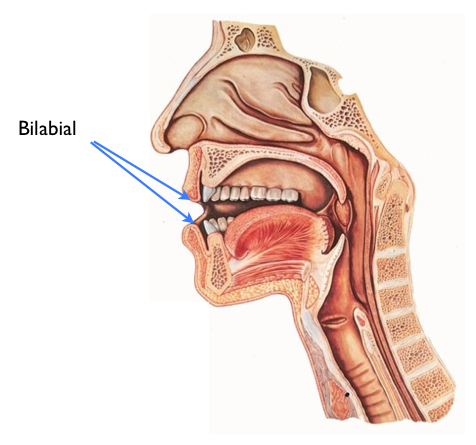 Bilabial consonants occur when you block/constrict airflow out of the mouth by bringing your lips together.
Bilabial consonants occur when you block/constrict airflow out of the mouth by bringing your lips together.
English contains the following three bilabial consonants:
/p/ as in “purse” and “rap“
/b/ as in “back” and “cab“
/m/ as in “mad” and “clam“
Labio-dental
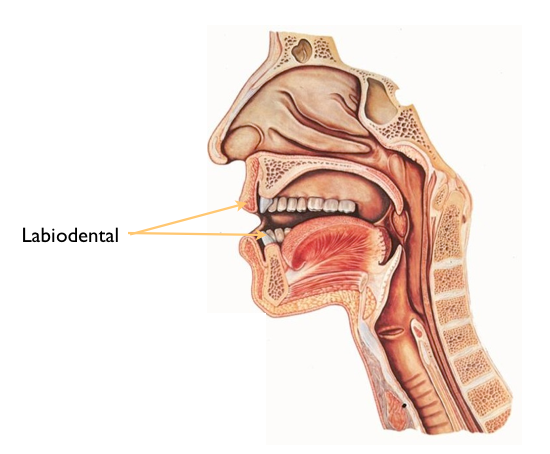 Labio-dental
consonants occur when you block/constrict airflow by curling your lower
lip back and raising it to touch your upper row of teeth.
Labio-dental
consonants occur when you block/constrict airflow by curling your lower
lip back and raising it to touch your upper row of teeth.
English contains the following two labio-dental sounds:
/f/ as in “fro” and “calf“
/v/ as in “vine” and “have”
Dental
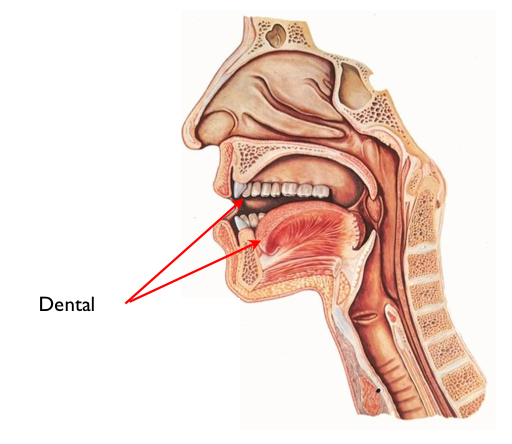 Dental consonants occur when you block/constrict airflow by placing your slimy tongue against your upper teeth.
Dental consonants occur when you block/constrict airflow by placing your slimy tongue against your upper teeth.
English contains the following two labio-dental sounds:
/θ/ as is “thick” and “bath“
/ð/ as in “the” and “rather”
Alveolar
You create Alveolar consonants when you raise your tongue to the alveolar ridge to block or constrict airflow.
The English alveolar consonants are as follows:
/n/ as in “no” and “man“
/t/ as in “tab” and “rat“
/d/ as in “dip” and “bad“
/s/ as in “suit” and “bus“
/z/ as in “zit” and “jazz“
/l/ as in “luck” and “fully”
Post-Alveolar
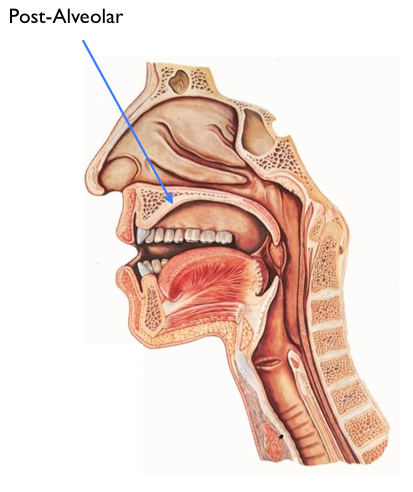 When
you retract your tongue back just a bit from the alveolar ridge, the
sounds change enough to be recognized as distinct consonants.
When
you retract your tongue back just a bit from the alveolar ridge, the
sounds change enough to be recognized as distinct consonants.
So
post-alveolar consonants are those that occur when the tongue blocks or
constricts airflow at the point just beyond the alveolar ridge.
The post-alveolar english consonants are as follows:
/ʃ/ as in “shot” or “brash”
/ʒ/ as in “vision” or “measure”
/tʃ/ as in “chick” or “match”
/dʒ/ as in “jam” or “badge“
Palatal
The
roof of your mouth is the hard palate. You may know it as “the place
that burns like hell when I eat pizza that is too hot.”
You create Palatal consonants when you raise the tongue to this point and constrict airflow.
English has only one palatal consonant:
/j/ as in “yes” and “bayou”.
Velar
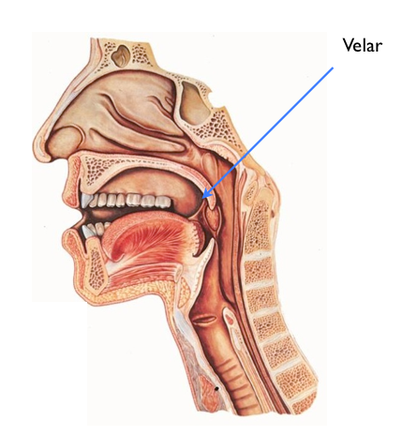 Behind
your hard palate you have the velum or soft palate. Unlike the bony
hard palate in front of it, the this consists of soft, mucousy tissue.
Behind
your hard palate you have the velum or soft palate. Unlike the bony
hard palate in front of it, the this consists of soft, mucousy tissue.
You make Velar Consonants when you raise the back of your tongue to the velum to block or restrict airflow.
English has the following velar consonants:
/ŋ/
as in “going” and “uncle” (note that the ‘n sound’ in these words is
NOT made at the alveolar ridge, which is why it is distinct from /n/).
/k/ as in “kite” and “back“
/g/ as in “good” and “bug“
/w/ as in “wet” and “howard”
Glottal
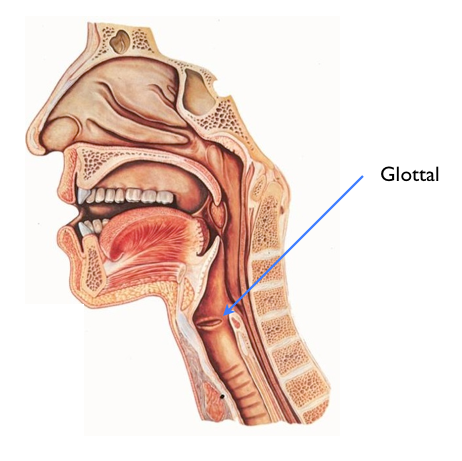 The glottis is actually two vocal folds (i.e. vocal cords). It acts as a sort of bottle cap to your windpipe.
The glottis is actually two vocal folds (i.e. vocal cords). It acts as a sort of bottle cap to your windpipe.
Inhale
and then hold your breath for a few seconds while keeping your mouth
open. What you are actually doing to keep the air from expelling out of
your lungs by closing your glottis.
Glottal
consonants aren’t actually consonants; they just play consonant roles
in the language. In English, the following things happen at the glottis:
/h/
as in “hi” and “Bahamas.” Say these words and notice how you’re not
actually constricting or blocking airflow for this /h/ sound. You’re
just exhaling a little bit harder than you would for a normal vowel
sound in transition to the following vowel sound.
/?/
– This is actually the culprit behind many of the “silent syllables” we
discussed in the first lesson. For example, in the phrase “wha(t) time
is it?” the /t/ in “what” is dropped and the vowel sound before it is
closed at the glottis.
Review
It takes a bit of time to develop a physical awareness of your speech organ. There are two reasons for this:
You can’t see your speech organ
You’ve been using the muscles of your speech organ every day of your life since your first breath.
Remember that whether you see it or not, the muscles of the speech organ can be controlled.
Don’t ever let anyone tell you that you’re incapable of a human speech sound. It’s just a question of knowing and practicing.
Come back to this page as often as you need to review this information.
Here’s the full chart again for your viewing pleasure:
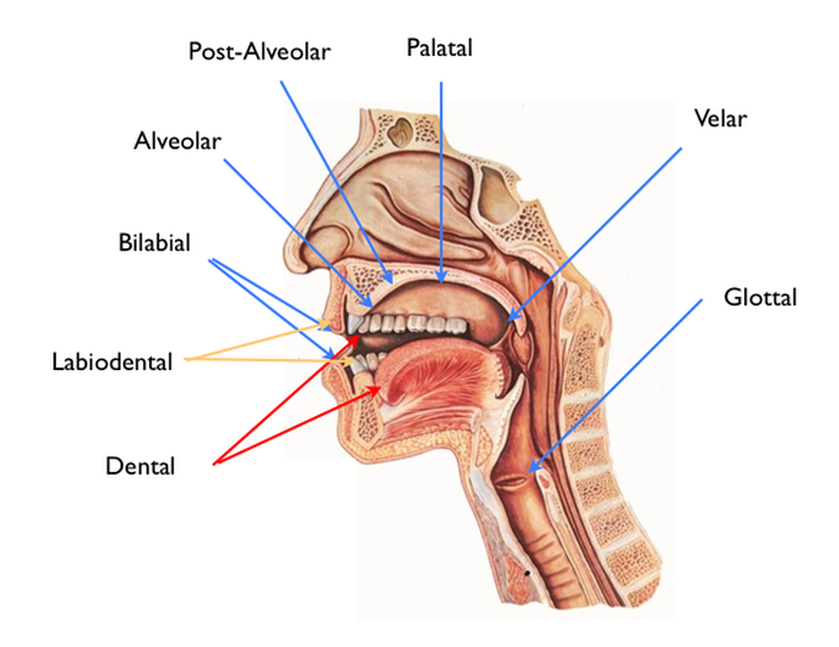
Before we move on I want to make a few important points:
I do NOT list all the possible places of articulation for human speech. These are just the ones for General American English.
I do NOT list all the possible consonant sounds. These are also just for General American English.
To
recap, the place of articulation is not the only feature that
determines the sound of a consonant. There is also manner of
articulation and phonation.
On the next page we will review these same English consonant sounds from their Manner of Articulation.
